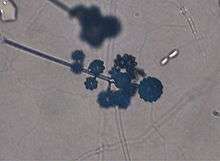Cunninghamellaceae
The Cunninghamellaceae are a family of fungi in the order Mucorales.[1]
| Cunninghamellaceae | |
|---|---|
 | |
| Cunninghamella echinulata | |
| Scientific classification | |
| Kingdom: | Fungi |
| Phylum: | Mucoromycota |
| Order: | Mucorales |
| Family: | Cunninghamellaceae Naumov ex R.K.Benj. (1959) |
| Type genus | |
| Cunninghamella Matr. (1903) | |
| Genera | |
| |
Taxonomy
At one time, this family contained four genera.[2] At present, the number of genera in this family is under debate.[3] According to Benny and Alexopoulos, the family only contains the genus Cunninghamella.[3][4] However, other (recent) authors have listed other genera, including Absidia, Halteromyces, and Hesseltinella.[5] The full list can be viewed at the webpage Cunninghamellaceae maintained by Gerald L. Benny.
Morphology
Hyphae are coenocytic and produce sporangiophores covered in calcium oxalate. Sporangiophores give rise to pedicellate, unispored sporangia.[4] In many cases, the wall of the sporangium and the spore have fused.[6] Zygospores tend to be ornamented and reddish-brown with opposed suspensors.[4]
Ecology
Cunninghamella species are commonly encountered in forest soils, dung,[4] and nuts from the tropics.[2] Species can be isolated using Czapek medium incubated for 3–4 days at 28-31C.[7] A few species are known human pathogens.[4]
External links
References
- "Cunninghamellaceae".
- Hesseltine C. W. & J. J. Ellis. 1973. Mucorales. in: The Fungi: An Advanced Treatise. Volume 5B. A Taxonomic Review with Keys: Basidiomycetes and Lower Fungi. Academic Press. New York. pg. 187-217.
- "Zygomycetes: Cunninghamellaceae".
- Alexopoulos C. J., C. W. Mims, & M. Blackwell. 1996. Introductory Mycology. Fourth Edition. John Wiley & Sons, Inc.
- Walther, G., Pawlowska, J., Alastruey-Izquierdo, A., Wrzosek, M., Rodriguez-Tudela, J. L., Dolatabadi, S., ... & de Hoog, G. S. (2013). DNA barcoding in Mucorales: an inventory of biodiversity. Persoonia, 30(1), 11-47.
- Kendrick, Bryce. 2000. The Fifth Kingdom. Third Edition. Focus Publishing & R. Pullins Company. Newburyport, MA.
- Mycology Guidebook Committee, Mycological Society of America. 1981. Mycology Guidebook. Editor: Russel B. Stevens. University of Washington Press Seattle, Washington.